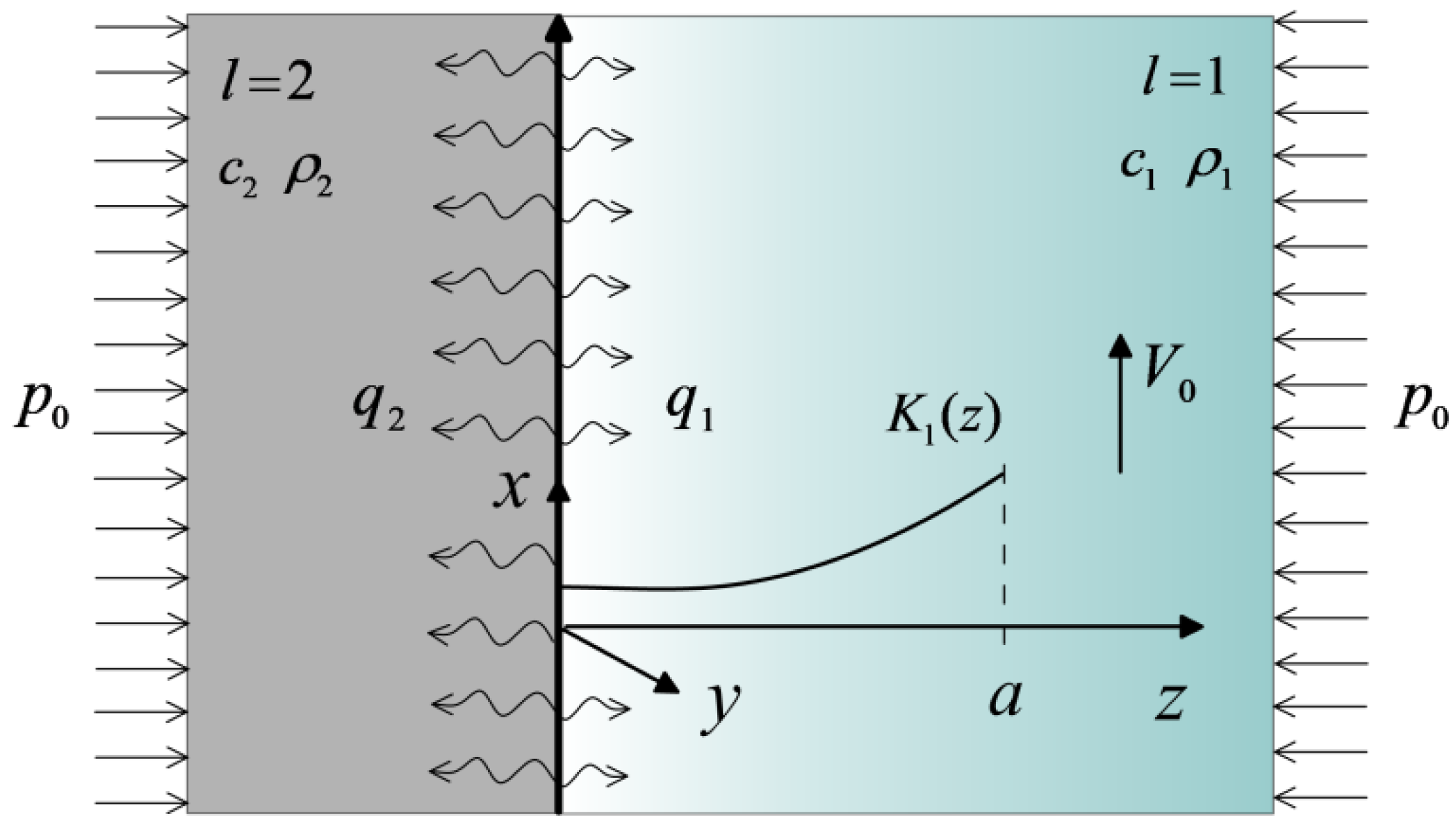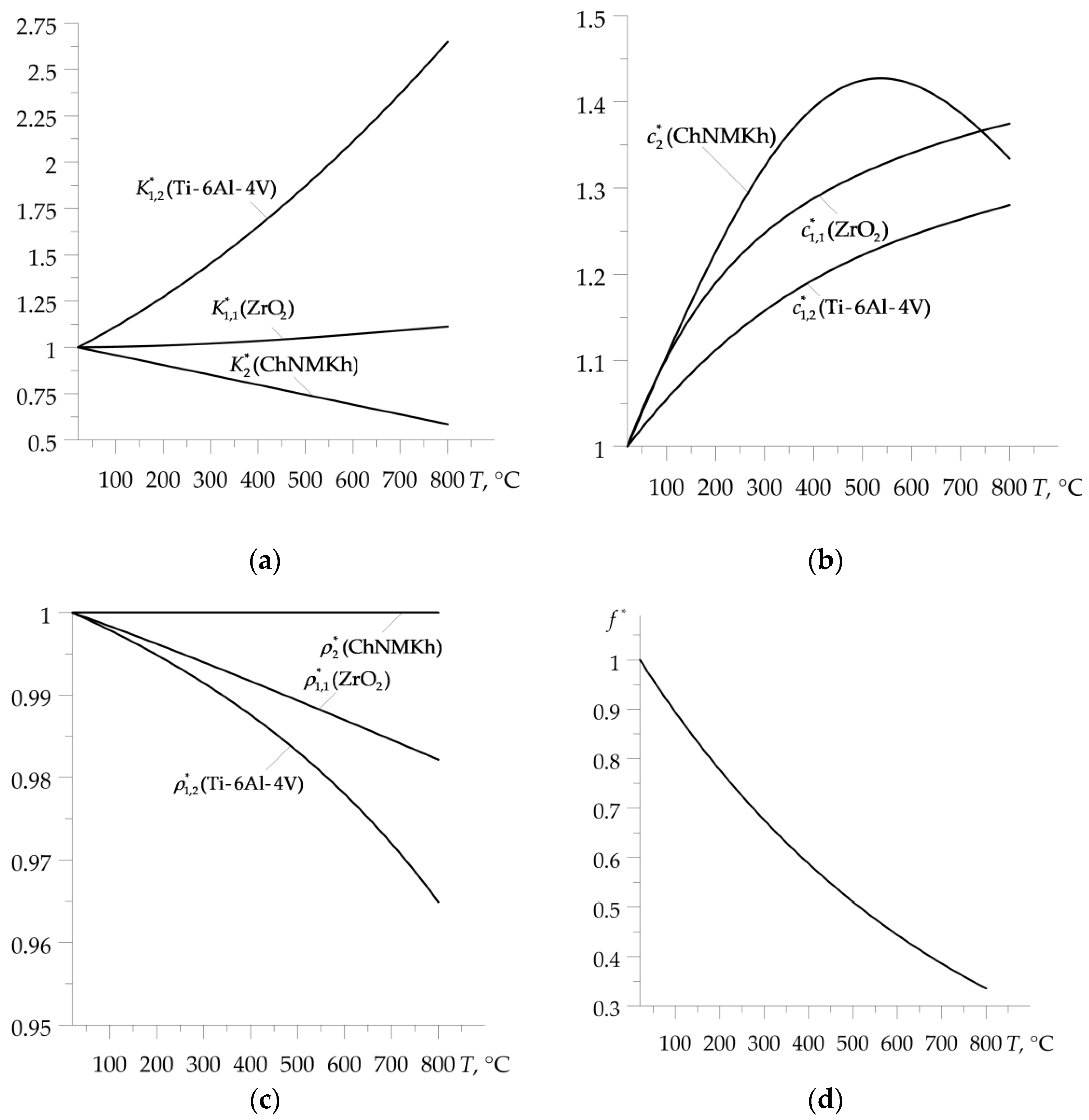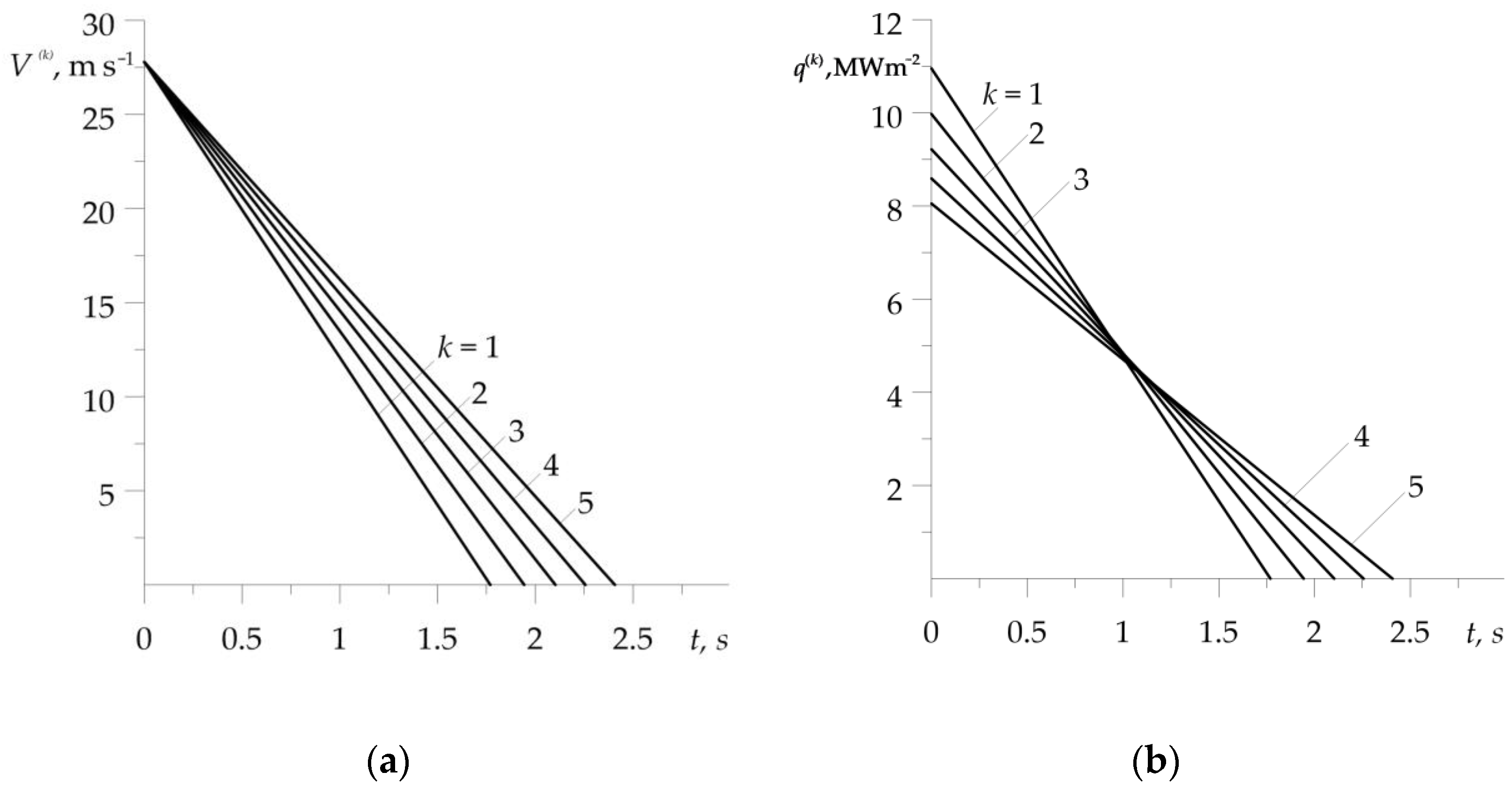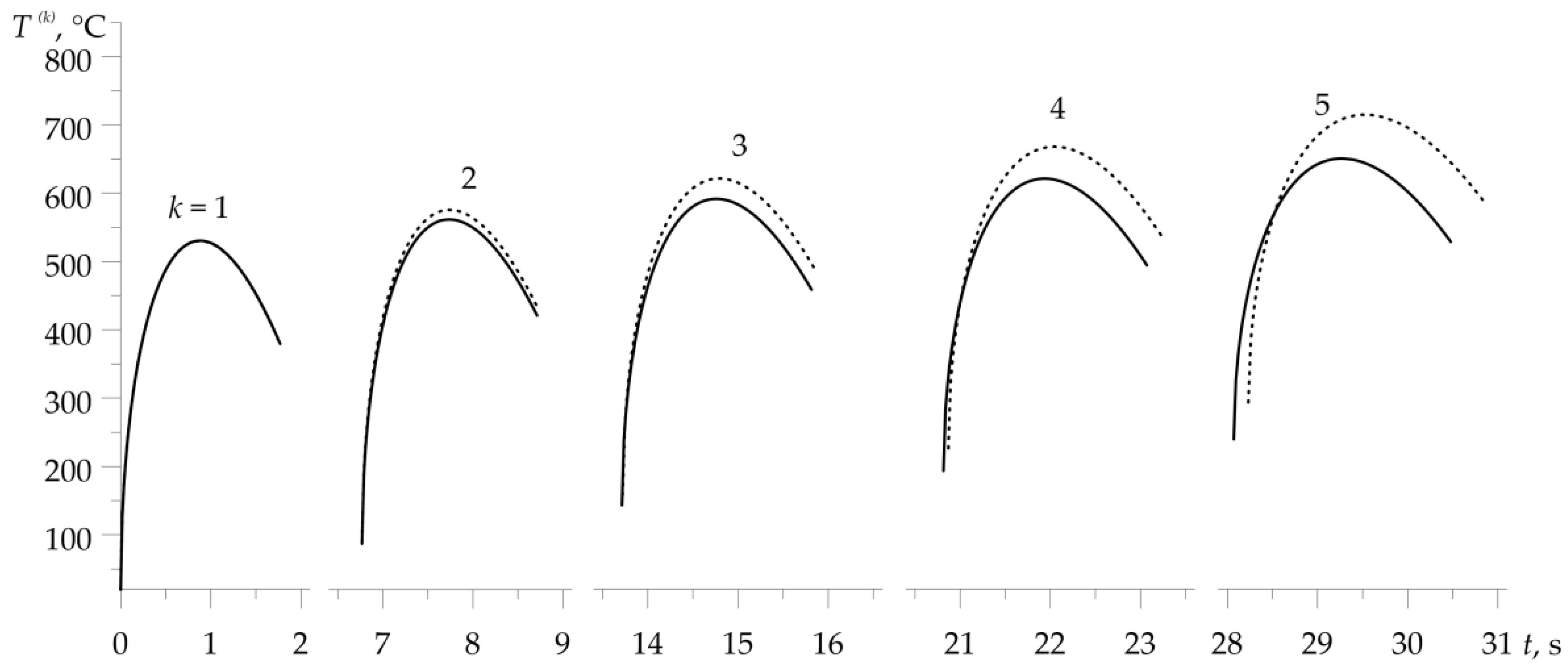Temperature during Repetitive Short-Term Operation of a Brake with Functionally Graded Friction Element
Abstract
1. Introduction
2. Scheme of Braking and Model Assumptions
- Initial temperature of considered a friction pair at the beginning of the subsequent braking is equal to the volume-averaged temperature of the system;
- As a result of the friction forces interaction, the heat is generated on the contact area of the elements and absorbed by them along the normal direction to the friction surface. The friction thermal contact of the elements during heating is perfect;
- Unforced convection cooling of the system during braking stages is omitted.
3. Analytical Model
4. Numerical Analysis
- Based on experimental data, finding the dependences of material properties and the friction coefficient on temperature in forms (6)–(10). Determining the value of material properties , , , , (7), , , (9) and the coefficient of friction (10) at the initial temperature ;
- Introduction of the input operational parameters: , , , , , , , , , , ,;
- Start of the first braking: ;
- Determination of the volume temperature (24)–(32);
- Using the dependencies (6)–(10), establishment of the material properties values , , , (19), , , (20), the friction coefficient , and specific friction power (21) at the volume temperature ;
- Determination of the stop time (2) and temporal profile of velocity , (1);
- Calculation of the temperature evolution , (11)–(23);
- Starting the next braking cycle and repeating starting from point (5) or ending the calculation process after reaching the equality .
5. Conclusions
Author Contributions
Funding
Institutional Review Board Statement
Informed Consent Statement
Data Availability Statement
Conflicts of Interest
Nomenclature
| Effective depth of heat penetration of the friction element () | |
| Area of the nominal contact region (m2) | |
| Area of the ventilated surface of the brake disc (m2) | |
| Specific heat () | |
| d | Thickness of friction elements () |
| Coefficient of friction (dimensionless) | |
| h | Coefficient of heat transfer () |
| Bessel functions of the first kind of the kth order | |
| Thermal diffusivity () | |
| Thermal conductivity () | |
| Dimensionless coefficient of thermal activity of friction couple | |
| n | Number of brakings in RST brake mode |
| Pressure on the contact surface (Pa) | |
| Nominal value of the contact pressure (Pa) | |
| Specific friction power () | |
| Nominal value of specific friction power () | |
| Time () | |
| tb | Time of performance of all RST mode of braking (s) |
| tc | Cooling time during acceleration stage (s) |
| Stop time () | |
| Temperature () | |
| Dimensionless temperature | |
| Volume temperature () | |
| Initial temperature () | |
| v | Volume fraction of the FGM components (dimensionless) |
| Velocity () | |
| Initial velocity () | |
| W0 | Initial kinetic energy (J) |
| Spatial coordinate in axial direction () | |
| Heat partition ratio (dimensionless) | |
| Parameter of material gradient () | |
| Scaling factor of temperature () | |
| Density () | |
| Dimensionless time | |
| Dimensionless time of braking | |
| superscript k | Number of a braking cycle |
| subscript l | Number of the friction pair element |
| subscript m | Number of the component material of functionally graded element |
References
- Grześ, P. Maximum temperature of the disc during repeated braking applications. Adv. Mech. Eng. 2019, 11, 1–13. [Google Scholar] [CrossRef]
- Yevtushenko, A.; Kuciej, M. Calculation of friction characteristics of disc brakes used in repetitive short-term braking mode. J. Frict. Wear 2020, 41, 509–516. [Google Scholar] [CrossRef]
- Yevtushenko, A.A.; Kuciej, M.; Grześ, P.; Wasilewski, P. Temperature in the railway disc brake at a repetitive short-term mode of braking. Int. Commun. Heat Mass Transf. 2017, 84, 102–109. [Google Scholar] [CrossRef]
- Adamowicz, A.; Grześ, P. Analysis of disc brake temperature distribution during single braking under non-axisymmetric load. Appl. Therm. Eng. 2011, 31, 1003–1012. [Google Scholar] [CrossRef]
- Adamowicz, A. Effect of convective cooling on temperature and thermal stresses in disk during repeated intermittent braking. J. Frict. Wear 2016, 37, 107–112. [Google Scholar] [CrossRef]
- Dunaevsky, V.V. Prediction of railroad friction braking temperatures: Prediction of average bulk and average surface temperatures of railroad wheels and brake discs. Tribol. Trans. 1991, 34, 343–352. [Google Scholar] [CrossRef]
- Yevtushenko, A.; Topczewska, K.; Kuciej, M. Analytical Determination of the Brake Temperature Mode during Repetitive Short-Term Braking. Materials 2021, 14, 1912. [Google Scholar] [CrossRef] [PubMed]
- Chichinadze, A.V.; Braun, E.D.; Ginzburg, A.G.; Ignat’eva, Z.V. Calculation, Testing and Selection of Friction Couples; Nauka: Moscow, Russian, 1979. (In Russian) [Google Scholar]
- Chichinadze, A.V. Polymers in Friction Assembles of Machines and Devices: A Handbook; Allerton Press Inc.: New York, NY, USA, 1984. [Google Scholar]
- Yevtushenko, A.; Kuciej, M.; Topczewska, K.; Zamojski, P. Temperature in the Friction Couple Consisting of Functionally Graded and Homogeneous Materials. Materials 2022, 15, 3600. [Google Scholar] [CrossRef] [PubMed]
- Yevtushenko, A.; Topczewska, K.; Zamojski, P. The Heat Partition Ratio during Braking in a Functionally Graded Friction Couple. Materials 2022, 15, 4623. [Google Scholar] [CrossRef] [PubMed]
- Yevtushenko, A.; Topczewska, K.; Zamojski, P. Influence of Thermal Sensitivity of Functionally Graded Materials on Temperature during Braking. Materials 2022, 15, 963. [Google Scholar] [CrossRef] [PubMed]
- Kingery, W.D.; Francl, J.; Coble, R.L.; Vasilos, T. Thermal Conductivity: X, Data for Several Pure Oxide Materials Corrected to Zero Porosity. J. American Ceramic Soc. 1954, 37, 107–110. [Google Scholar] [CrossRef]
- Pankratz, L.B. Thermodynamic Properties of Elements and Oxides-Bulletin 672; U.S. Bureau of Mines: Washington, DC, USA, 1982.
- Taylor, D. Thermal expansion data. II: Binary oxides with the fluorite and rutile structures, MO2, and the antifluorite structure, M2O. Trans. J. British Ceramic Soc. 1984, 83, 32–37. [Google Scholar]
- Deem, H.W.; Wood, W.D.; Lucks, C.F. The relationship between Electrical and Thermal Conductivities of Titanium Trans. Metall. Soc. AIME 1958, 212, 520–523. [Google Scholar]
- Cezairrliyan, A.; McClure, J.L.; Taylor, R.J. Thermophysical Measurements on 90Ti-6Al-4V Alloy Above 1450 K Using a Transient (Subsecond) Technique. J. Res. Nat. Bur. Stand.–A Phys. Chem. 1977, 81, 251–256. [Google Scholar] [CrossRef]
- Chichinadze, A.V.; Matveevskii, R.M.; Braun, E.P. Materials in Triboengineering of Unsteady Processes; Nauka: Moscow, Russia, 1986. [Google Scholar]
- Fu, P.; Zhao, J.; Zhang, X.; Kang, G.; Wang, P.; Kan, Q. Thermo-mechanically coupled sliding contact shakedown analysis of functionally graded coating-substrate structures. Int. J. Mech. Sci. 2022, 222, 107241. [Google Scholar] [CrossRef]
- Delouei, A.A.; Emamian, A.; Karimnejad, S.; Sajjadi, H. A closed-form solution for axisymmetric conduction in a finite functionally graded cylinder. Int. Commun. Heat Mass Transf. 2019, 108, 104280. [Google Scholar] [CrossRef]
- Delouei, A.A.; Emamian, A.; Karimnejad, S.; Sajjadi, H.; Jing, D. Two-dimensional analytical solution for temperature distribution in FG hollow spheres: General thermal boundary conditions. Int. Commun. Heat Mass Transf. 2020, 113, 104531. [Google Scholar] [CrossRef]






| k | 1 | 2 | 3 | 4 | 5 |
|---|---|---|---|---|---|
| 0.27 | 0.25 | 0.23 | 0.21 | 0.20 | |
| 1.77 | 1.94 | 2.10 | 2.26 | 2.41 | |
| 20 | 86.85 | 143.21 | 193.48 | 239.74 | |
| 530.27 | 561.29 | 591.46 | 621.11 | 650.49 |
| k | 1 | 2 | 3 | 4 | 5 |
|---|---|---|---|---|---|
| 0.27 | 0.24 | 0.22 | 0.20 | 0.18 | |
| 1.77 | 1.95 | 2.15 | 2.36 | 2.60 | |
| 20 | 89.83 | 158.79 | 226.89 | 294.12 | |
| 530.27 | 575.76 | 621.75 | 668.19 | 715.04 |
| k | 1 | 2 | 3 | 4 | 5 |
|---|---|---|---|---|---|
| 0.149 | 0.142 | 0.135 | 0.129 | 0.123 | |
| 0.553 | 0.576 | 0.593 | 0.608 | 0.620 | |
| 0.489 | 0.515 | 0.534 | 0.550 | 0.563 | |
| , | 0.177 | 0.153 | 0.134 | 0.119 | 0.107 |
Disclaimer/Publisher’s Note: The statements, opinions and data contained in all publications are solely those of the individual author(s) and contributor(s) and not of MDPI and/or the editor(s). MDPI and/or the editor(s) disclaim responsibility for any injury to people or property resulting from any ideas, methods, instructions or products referred to in the content. |
© 2023 by the authors. Licensee MDPI, Basel, Switzerland. This article is an open access article distributed under the terms and conditions of the Creative Commons Attribution (CC BY) license (https://creativecommons.org/licenses/by/4.0/).
Share and Cite
Yevtushenko, A.; Topczewska, K.; Zamojski, P. Temperature during Repetitive Short-Term Operation of a Brake with Functionally Graded Friction Element. Materials 2023, 16, 881. https://doi.org/10.3390/ma16020881
Yevtushenko A, Topczewska K, Zamojski P. Temperature during Repetitive Short-Term Operation of a Brake with Functionally Graded Friction Element. Materials. 2023; 16(2):881. https://doi.org/10.3390/ma16020881
Chicago/Turabian StyleYevtushenko, Aleksander, Katarzyna Topczewska, and Przemysław Zamojski. 2023. "Temperature during Repetitive Short-Term Operation of a Brake with Functionally Graded Friction Element" Materials 16, no. 2: 881. https://doi.org/10.3390/ma16020881
APA StyleYevtushenko, A., Topczewska, K., & Zamojski, P. (2023). Temperature during Repetitive Short-Term Operation of a Brake with Functionally Graded Friction Element. Materials, 16(2), 881. https://doi.org/10.3390/ma16020881








